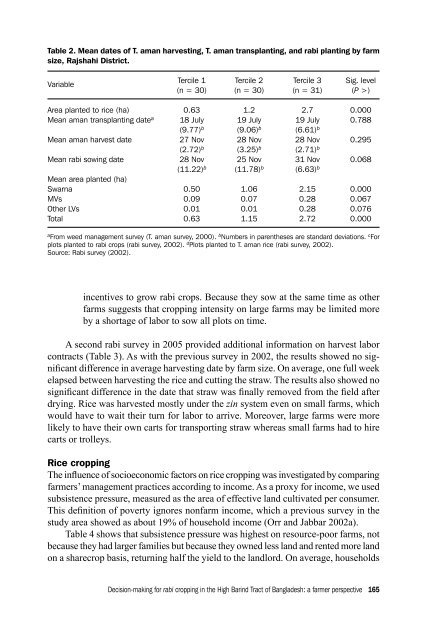Download (2461kB) - University of Greenwich
Download (2461kB) - University of Greenwich
Download (2461kB) - University of Greenwich
- No tags were found...
Create successful ePaper yourself
Turn your PDF publications into a flip-book with our unique Google optimized e-Paper software.
Table 2. Mean dates <strong>of</strong> T. aman harvesting, T. aman transplanting, and rabi planting by farmsize, Rajshahi District.VariableTercile 1 Tercile 2 Tercile 3 Sig. level(n = 30) (n = 30) (n = 31) (P >)Area planted to rice (ha) 0.63 1.2 2.7 0.000Mean aman transplanting date a 18 July 19 July 19 July 0.788(9.77) b (9.06) b (6.61) bMean aman harvest date 27 Nov 28 Nov 28 Nov 0.295(2.72) b (3.25) b (2.71) bMean rabi sowing date 28 Nov 25 Nov 31 Nov 0.068(11.22) b (11.78) b (6.63) bMean area planted (ha)Swarna 0.50 1.06 2.15 0.000MVs 0.09 0.07 0.28 0.067Other LVs 0.01 0.01 0.28 0.076Total 0.63 1.15 2.72 0.000a From weed management survey (T. aman survey, 2000). b Numbers in parentheses are standard deviations. c Forplots planted to rabi crops (rabi survey, 2002). d Plots planted to T. aman rice (rabi survey, 2002).Source: Rabi survey (2002).incentives to grow rabi crops. Because they sow at the same time as otherfarms suggests that cropping intensity on large farms may be limited moreby a shortage <strong>of</strong> labor to sow all plots on time.A second rabi survey in 2005 provided additional information on harvest laborcontracts (Table 3). As with the previous survey in 2002, the results showed no significantdifference in average harvesting date by farm size. On average, one full weekelapsed between harvesting the rice and cutting the straw. The results also showed nosignificant difference in the date that straw was finally removed from the field afterdrying. Rice was harvested mostly under the zin system even on small farms, whichwould have to wait their turn for labor to arrive. Moreover, large farms were morelikely to have their own carts for transporting straw whereas small farms had to hirecarts or trolleys.Rice croppingThe influence <strong>of</strong> socioeconomic factors on rice cropping was investigated by comparingfarmers’ management practices according to income. As a proxy for income, we usedsubsistence pressure, measured as the area <strong>of</strong> effective land cultivated per consumer.This definition <strong>of</strong> poverty ignores nonfarm income, which a previous survey in thestudy area showed as about 19% <strong>of</strong> household income (Orr and Jabbar 2002a).Table 4 shows that subsistence pressure was highest on resource-poor farms, notbecause they had larger families but because they owned less land and rented more landon a sharecrop basis, returning half the yield to the landlord. On average, householdsDecision-making for rabi cropping in the High Barind Tract <strong>of</strong> Bangladesh: a farmer perspective 165
















